Moghrabieh in the Camp
Hisham Assaad writes about making Moghrabieh and the preservation of recipes in Dbayeh, a Palestinian refugee camp near Beirut. Plus his mother's recipe for Moghrabieh and Maftoul.
Good morning, and welcome to Vittles! Today, Hisham Assaad writes about his family’s ritual of making moghrabieh, and reflects on the act of sharing Palestinian recipes today. You will find his mother’s recipe for moghrabieh and maftoul below.
There is no paywall on today’s recipe: instead we would encourage you to donate to a project attempting to alleviate the effects of starvation in Palestine. The Sameer Project is currently raising funds for tents, food and water in north and south Gaza and you can donate via the links below.
Moghrabieh in the Camp
It’s a cold, rainy morning in January, 2010, the day of my 22nd birthday. I am happily keeping warm by the oven while my birthday cake bakes in the living room of our small house in the Palestinian refugee camp in Dbayeh, roughly 15 km north of Beirut. In the kitchen, my mother sits by a large shallow basin in which she is rolling cracked wheat with flour and water to make maftoul. The maftoul will accompany the moghrabieh that she makes every year on my birthday. Soon, it will be time for our friends and family to gather at a table set with mismatched plates and bowls to enjoy the stew.
Moghrabieh is thought to have originated in northwest Africa – Al Maghreb, the lands where the sun sets. For Palestinians, moghrabieh is the name for a stew made of a rich bone broth with chickpeas, pearl onions and spices, which is served alongside maftoul. (For Lebanese and Syrian people, ‘mohgrabieh’ refers to both the stew and the semolina balls it is served with.) In my family, it’s a dish for special occasions, rich in flavour from lamb shanks that are simmered for hours with bay leaves, cardamom pods, cinnamon, cloves, and nutmeg, with the soft onions bringing a burst of sweetness.
My family has lived in the camp in Dbayeh since 1997, before which we lived in the UAE, where my sisters and I were born. Like thousands of other families, my ancestors were expelled from their village Al Bassa in Northern Palestine by Israel during the Nakba in 1948. Even today, my family still makes a lot of dishes that they carried with them from their village: msakhan, made with chicken, sumac, and onions; mhammar, a chicken and potato traybake; and kaak asfar, turmeric-flavoured Easter bread.
When we arrived in Dbayeh camp, it was a big adjustment from the UAE: from a neighbourhood of independent houses with several rooms and wide, lit streets, we moved to one with tiny houses stacked side by side like building blocks, nestled among tight alleyways, subject to constant power cuts, where most people spoke in a dialect different from us. But once we were settled and comfortable, we started building traditions, one of which is the moghrabieh gatherings, headed by my mother, who would cook to feed at least fifteen people so that everyone could take a portion home.
These gatherings persist to this day, with my mother still making the maftoul from scratch. When I was a child, she and my grandmother would involve all of us kids in rolling the cracked wheat and water. More often than not we would end up with clumps in our bowls rather than pearls; my mother would skillfully reintegrate our efforts into her batch and roll them into perfect little orbs. Even now, I can’t always apply the right amount of pressure to the grains (too little and they don’t roll or accumulate flour, too much and they clump up). To me and everyone around, my mother is still the queen of maftoul.
With this recipe, I invite you to make Palestinian maftoul the way my family prepares it. If you cannot, then just make the stew following my mom’s recipe, and serve it with store-bought Lebanese moghrabieh pearls (made from semolina): don’t worry, we won’t judge. To us, and to many families across Palestine, Mograbieh is always a big deal. It it is a part of our heritage, which we keep alive by sharing with others. As Israeli occupation and colonialism makes us refugees repeatedly, today, it feels more important than ever to share stories about my family, our food, the camp, and Palestine.
Mograbieh
In addition to the maftoul, what distinguishes my mother’s moghrabieh from its Lebanese counterpart is the spices she uses. Lebanese mohgrabieh tends to include lots of caraway, whereas in this version the spices are more minimal – just enough to give the dish flavour and complement the meat.
Serves 10–12
Time 4 hrs
Ingredients
for the maftoul
250g cracked wheat
1 tbsp yeast
½ tsp salt
180ml olive oil, plus 2tbsp
1.5kg flour
20g unsalted butter
½ tsp salt
1 tsp ground cinnamon
¼ tsp ground nutmeg
1 tsp ground caraway
for the moghrabieh
300g dried chickpeas, soaked overnight (or 1kg canned cooked chickpeas)
50ml olive oil
2kg bone-in lamb shanks with bones (or a mix of your preferred beef and lamb parts)
2kg small or pearl onions
3 cinnamon sticks
7–8 cardamom pods
1 whole nutmeg, halved
4–5 cloves
2 bay leaves
salt to taste
Method
First, make the maftoul. Soak the cracked wheat in water for 30 mins then drain well.
In a bowl, dissolve the yeast and salt in 360ml water. Add 180ml olive oil, then set aside.
Place the drained cracked wheat in a wide, shallow bowl. Sprinkle in a handful of flour and move the wheat around the base of the bowl with your palm in a circular motion. Once the flour has coated the grains, drizzle 1 tbsp of the liquid mixture over the cracked wheat and roll in the bowl, applying gentle pressure. Once the liquid is absorbed, sprinkle over a handful of flour and roll again with gentle pressure. (Here is an old video of my mother rolling maftoul for guidance.)
Repeat the process, alternating between the liquid mixture and flour once the added element is absorbed. Eventually you will start to get small pearls. Keep on going, until all the flour and liquid has been added and the pearls are at least three or four times their original size – it could take 40–90 mins, depending on the pearl size you’d prefer. Lay the pearls in a single layer on a piece of cloth and cover loosely with a plastic sheet or clean tea towel for at least a couple of hours (or preferably overnight to rest).
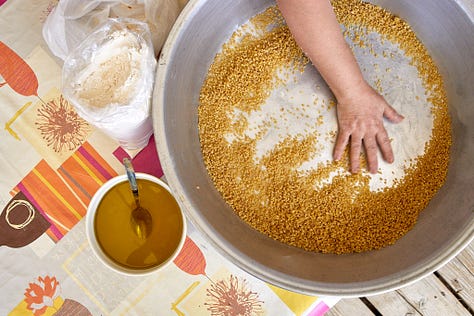
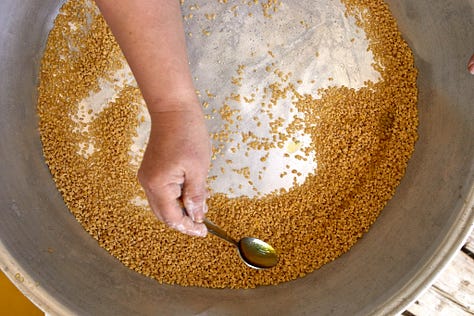
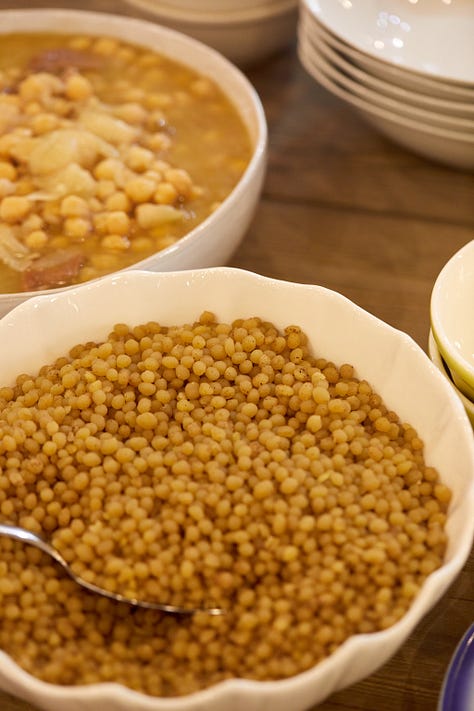
If you’re using dried, soaked chickpeas, place them in a pot, cover generously with water and bring to the boil. Simmer for 45 mins or until soft (you could also use the pressure cooker or instant pot). If you’re using canned cooked chickpeas, you can skip this step.
Now, make the moghrabieh. Place a large pot over a high heat. Coat the base of the pot with olive oil, then sear the meat on all sides. Add the onions and spices and aromatics and cover with water. Once the liquid starts to boil, remove the froth with a slotted spoon, then reduce the heat, cover with a lid and simmer for at least 1 hr.
Carefully add the cooked chickpeas, cover with a lid, and simmer for another 1 hr.
Toss the maftoul in 2tbsp olive oil, breaking apart any that have clumped together. Coat a colander or a steamer that fits perfectly over the top of the pot with a little oil too and carefully add the maftoul.
Place the colander over the simmering stew, making sure the bottom of the colander doesn’t touch the liquid. Cover with a cloth and steam for 30 mins, stirring occasionally with a skewer or carving fork to avoid crushing the maftoul.
Check if the maftoul is done by tasting a few pearls – you want the centre to be cooked through but still with a slight bite. Transfer the pearls into a bowl and toss with the butter, salt, cinnamon, nutmeg, and caraway.
Taste the moghrabieh and add salt as needed. Serve over a layer of maftoul.
Notes
The maftoul is best fresh immediately after steaming and seasoning. You can refrigerate it for around five days in a sealed container. Steam to reheat before serving. The moghrabieh will keep in the fridge for up to a week. Boil it on the stove to reheat before serving.
In the UK, you can buy prepared Maftoul from Zaytoun. Cook them according to packet instructions.
Subscribe to Vittles to get access to more recipes, features, restaurant writing and our entire back catalogue.
Credits
Hisham Assaad is a Lebanese-Palestinian cook, writer, and food photographer who has been regularly sharing recipes and stories on his blog cookin5m2.com since 2013. He has authored two books: Bayrut: The Cookbook and Taboon. You can find him on Instagram here.
This recipe was tested by Sanskriti Bist.
The full Vittles masthead can be found here.


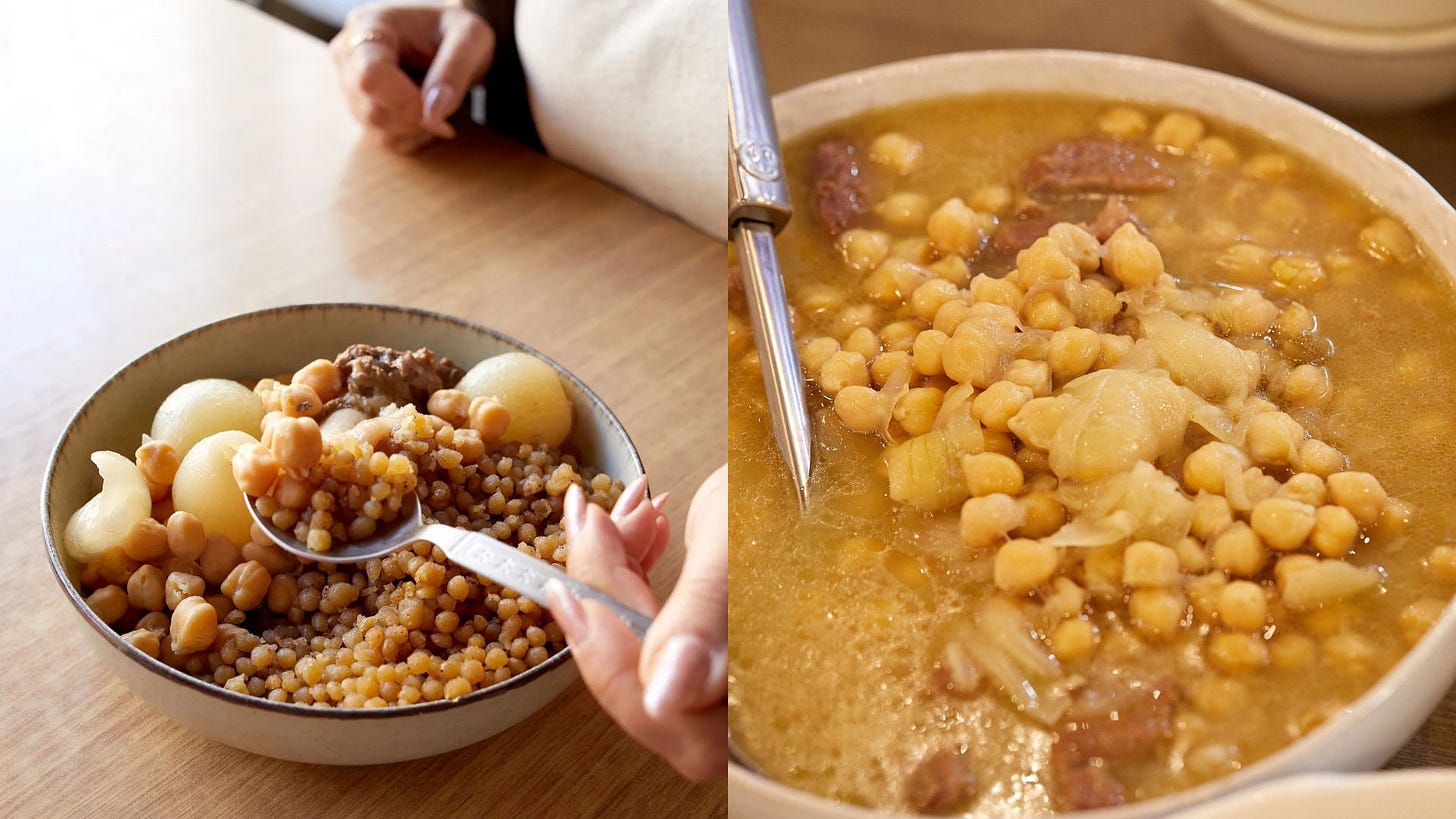
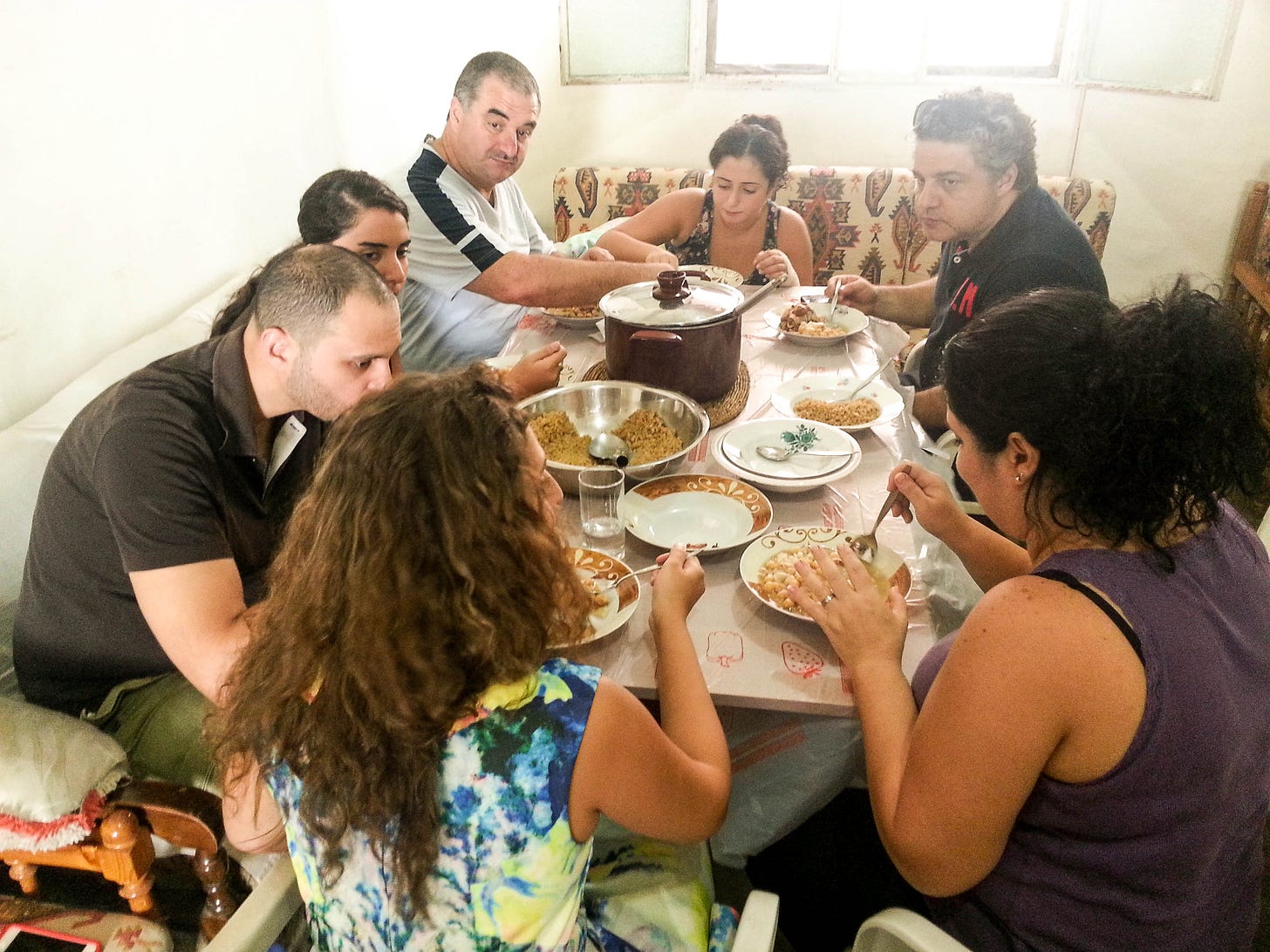
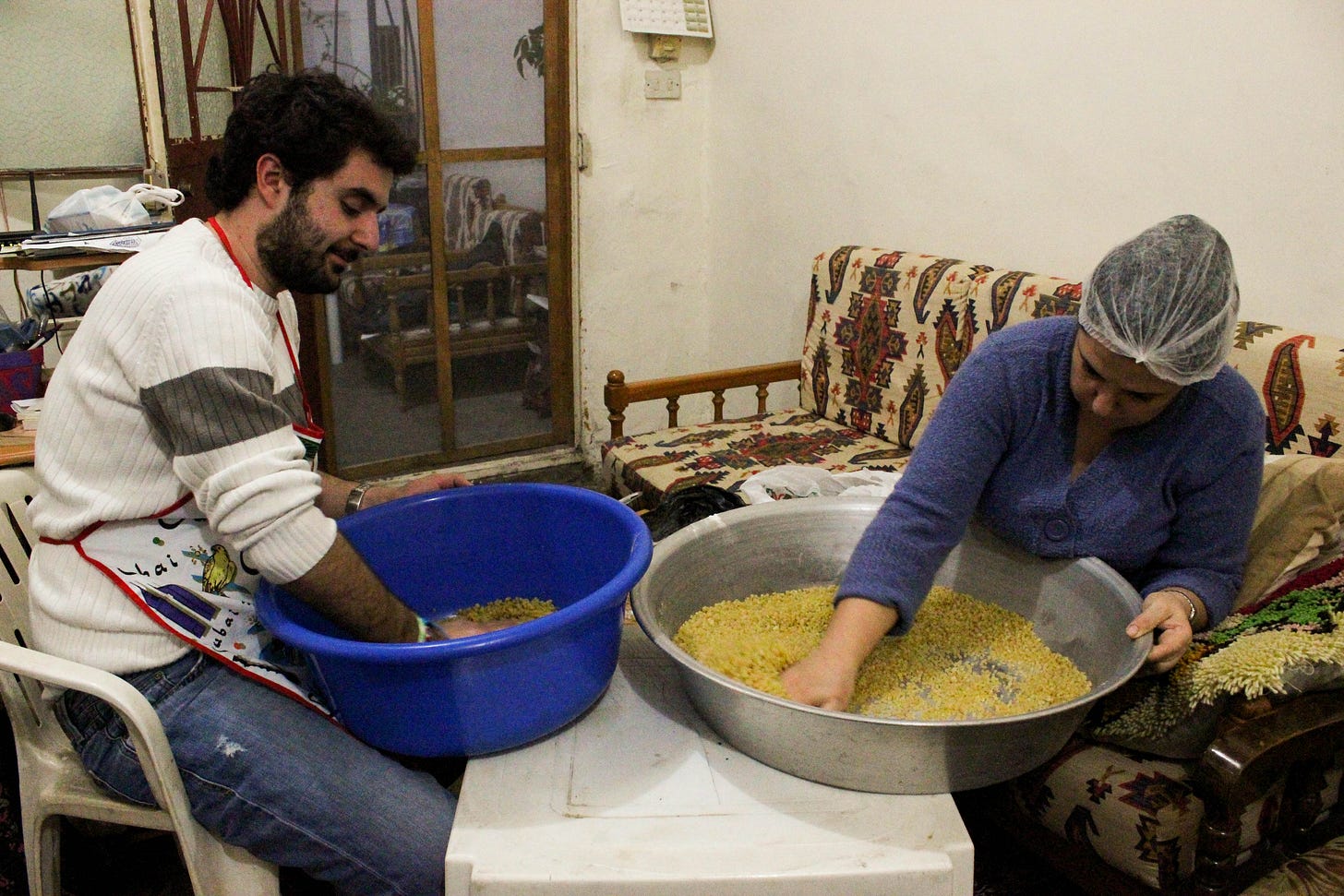
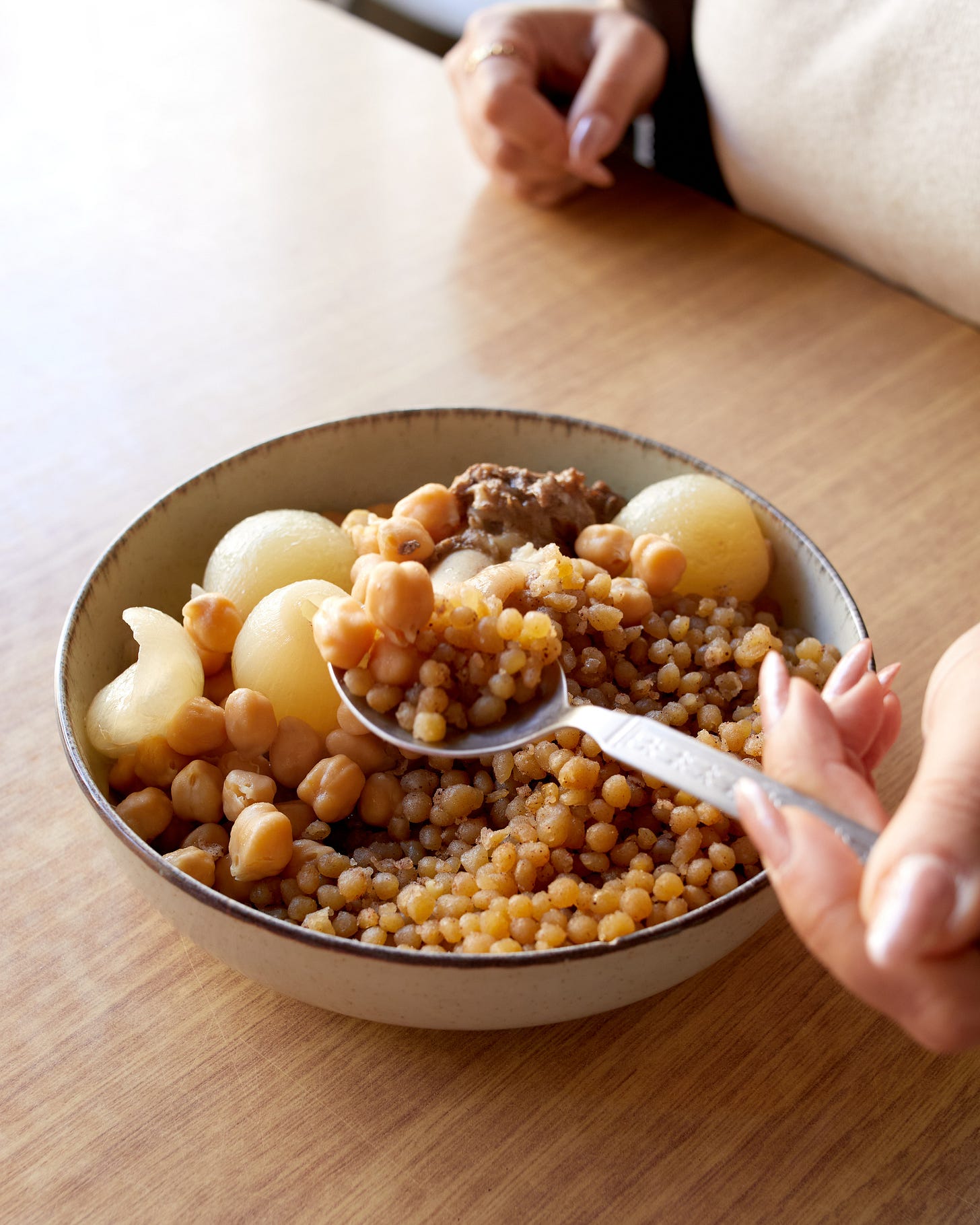
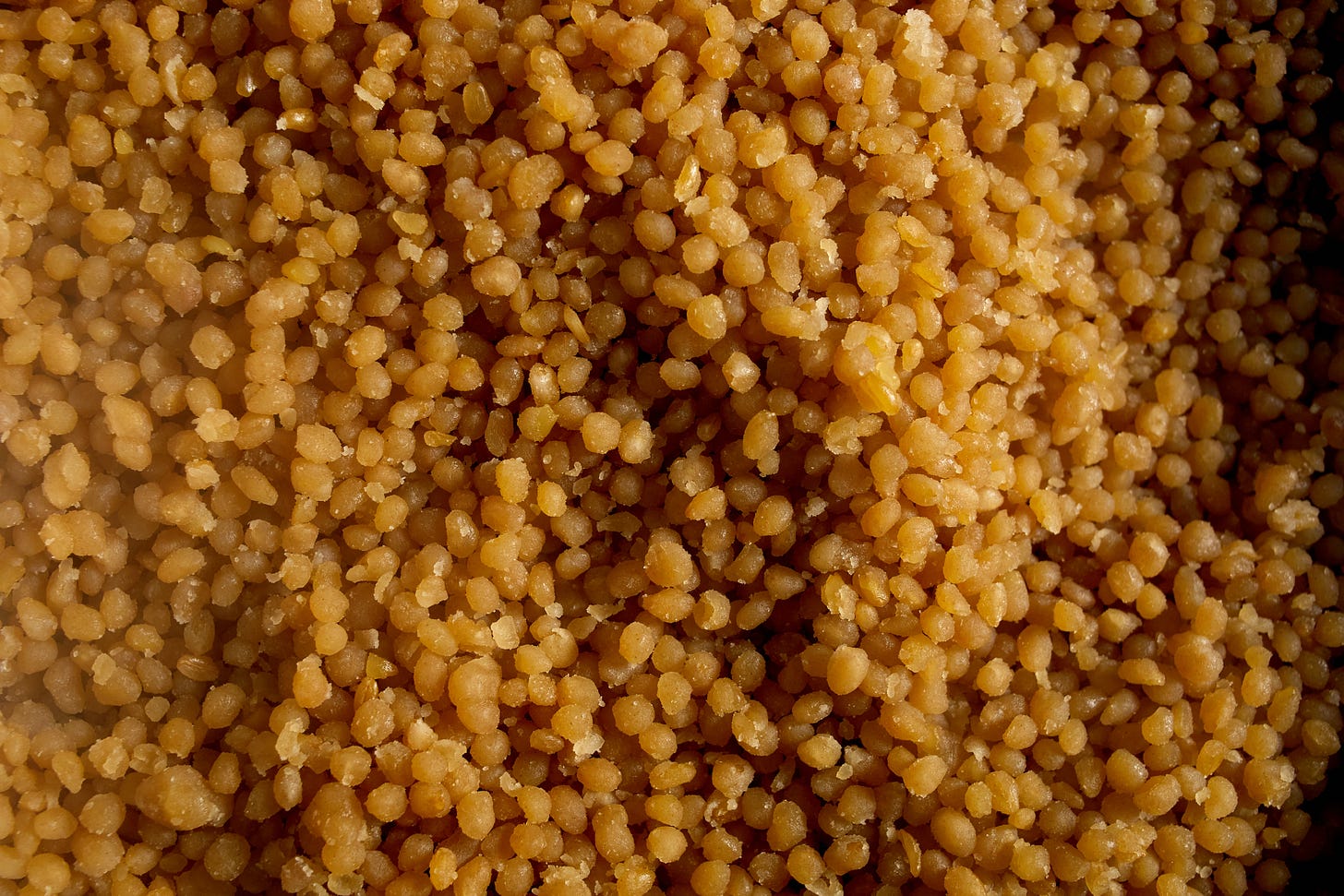
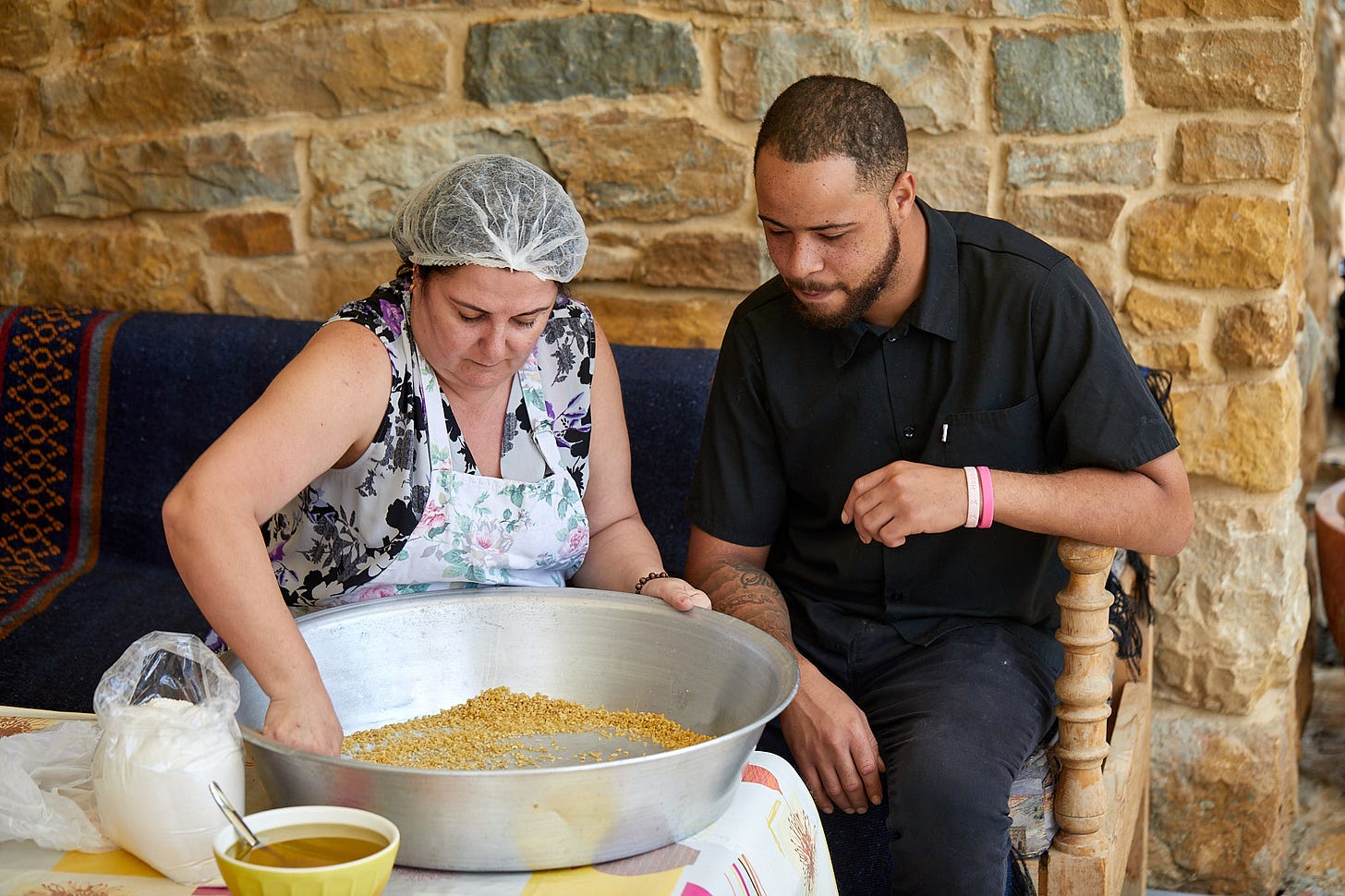
One of my favourite dishes that reminds me of home!
I love this article, thanks Vittles. The best recipes are infused with family stories.